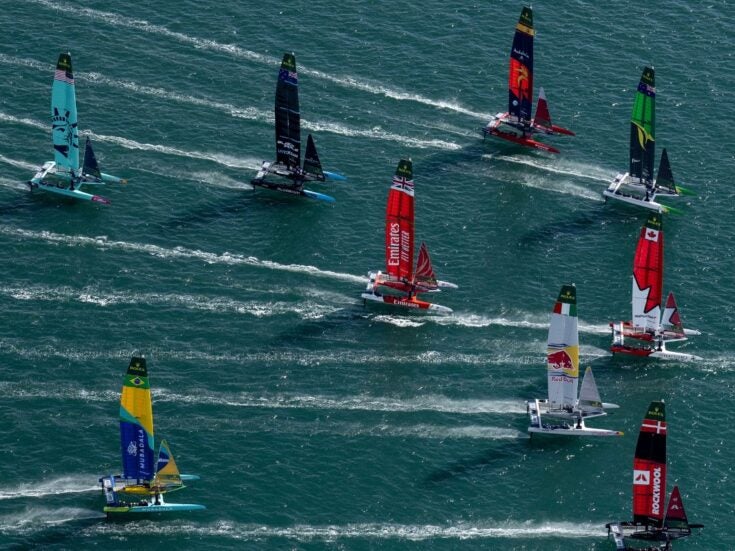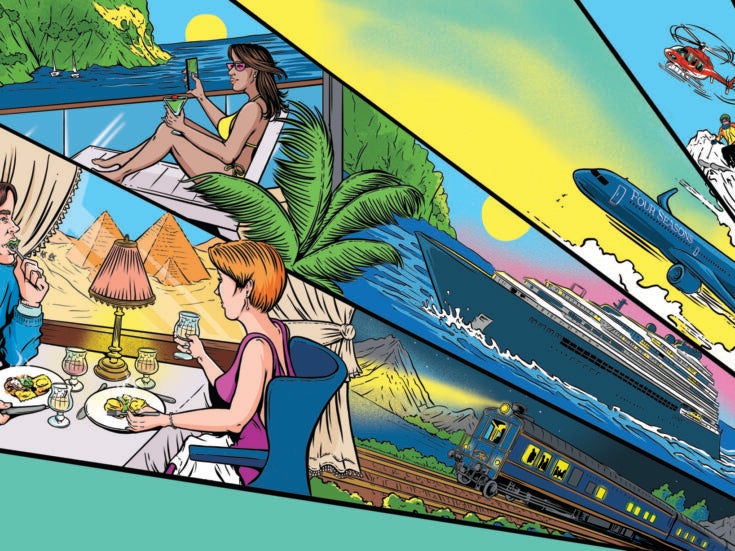
Our man on the dune Max Johnson goes into orbit over the magnificent wildlife and jaw-dropping landscapes of little-visited Namibia
WE HAD STOPPED the 4×4 in the dried-up Hoab riverbed. The dust flicked up by the tyres settled on the bonnet and my white linen shirt. My guide Michael switched off the engine and we continued to look at the herd of sixteen desert-adapted elephants walking metres away from us.
‘You know, Max,’ my guide Michael said, ‘these experiences you are having can never be taken away from you.’ Cheesy, perhaps, but not wrong.
‘What do you want to call that one?’ A young bull elephant had loomed into view, browsing the foliage of an acacia tree. It was docile, thankfully, and not in musth, when an elephant’s testosterone levels go wild and it becomes aggressive.
‘How about Harry?’
‘Harry it is, then.’
Most people go on safari in the northern hemisphere’s summertime, Africa’s winter, because it’s cooler and you see more game in the dry season. Those same people were rather doubtful about my grand ambitions to explore Namibia in one week during Africa’s summer, but when Namibia Tracks and Trails invited me I leapt at the opportunity.

By the end of day three I had seen 21 elephants, two hyenas, one caracal (an extremely rare desert lynx), six black rhino, countless oryx (which by the way tastes fantastic) and more birds than I knew existed. By the end of the week I had seen bush savannah, the tallest sand dunes in the world, salt pans and seal-studded beaches. Its variety is unexpected, and humbling.
I was to start in Windhoek, the capital, and overnight there. Then my guide — the highly sought-after Falco Moisel — was to drive me to the Etosha National Park on the second day through the small towns of Okahandja and Otjiwarongo. I would swing west through Etosha and then fly by chartered Cessna out to Damaraland, and after two nights continue flying south along the Skeleton coast to Sossusvlei in the Namib desert.
SINCE INDEPENDENCE FROM South Africa in 1990, Namibia has swung from white-minority apartheid rule to a parliamentary democracy of just over two million people relatively successfully. Compared with other members of the Southern African Development Community — Zimbabwe, for example — it is a triumph.
After more than a century of foreign occupation — first German, then South African (or ‘British’, as the South Africans like to say) — it is only now that Namibia has had a chance to develop. Mining and farming are key industries, but they have not developed fast, and the economy is perilously dependent on mineral exports. Nor has Namibia decoupled fully from South Africa’s much larger economy.
Nevertheless, as Falco would later explain in the car, ‘Following independence, tourism really kicked off. During the apartheid people did not want to come, but now that there is political and economic stability it has never been a better time.’ When I mentioned the G4S security vehicles everywhere, the high fences and the barbed wire, he replied: ‘TIA: This Is Africa.’
My hotel, then, was plainly not Africa, by those standards anyway. The suite at the Olive Exclusive Boutique Hotel was complete with fireplace and dining room which opened out to decking with a private plunge pool. The midday heat of the Namibian sun is pleasantly fended off by submerging oneself in your plunge pool.

The seven-hour drive the next day from Windhoek to Onguma Plains Camp, which borders the Etosha National Park, was made effortless thanks to the smooth modern roads and, frankly, the luxury of doing none of the driving. I sank back in my seat and watched the termite mounds and mopane trees blur by.
As we drew up at the lodge, I thought we had arrived at a desert fort of the French Foreign Legion — a beautiful stone construction with 360° viewing decks of bush savannah and a watering hole. Sunset was approaching. To the left the bush rustled and a hyena slunk its way toward the watering hole. The sky tinted pink, red and finally orange as the sun faded away.
THE ADVANTAGE OF booking through Namibia Tracks and Trails is its network of luxury lodges throughout the country. Too often we passed run-down lodges, the resort of uninformed holidaymakers. Although a stone’s throw from Etosha, Onguma boasts 34,000 hectares of its own reserve. Here you can choose the desert-inspired fort, head for the intimate tented camp on the banks of a waterhole, or nestle yourselves in the six-person treetop camp and spy on the animals as the watering hole comes to life.
The next day, we entered the Etosha National Park. The explorers Charles John Andersson and Francis Galton discovered the Etosha Pan in 1851, but even today few people know that it is one of the best game viewing parks in the whole of Africa, with a bewildering array of species of bird and no queue of 4x4s at the many watering holes we visited. Etosha derives its name, which means ‘a huge white area’, from its salt flat with its shimmering crystals.
If you spend the entire day in the park, you may well need — as I did — a lodge on the other side of the park, in which case the best ones are the Ongava Lodge or the ultra-high-end Little Ongava. As I was shaving that evening in the Ongava Lodge, four black rhino came to the waterhole in front of my room to drink.
Commercial flights be damned, after Etosha Wilderness Safaris flew me on their own airline to their Doro Nawas camp in Damaraland in the north, and then a few days later to Little Kulala lodge in Sossusvlei, where the temperature soared to 35°C. Damaraland is in the semi-desert part of Namibia: it was there that I went desert-elephant trekking and nighttime scorpion hunting. The beautiful lodge is made up of abode-styled thatched bungalows on raised platforms, and the hotel is run largely by the local community. It has so impressed others with its forward-thinking approach that it won the WTTC Tourism for Tomorrow Award.

Sossusvlei is an extraordinary place where sand hills can reach a height of 300 metres. As well as sand-dune climbing I could have gone riding, hiking or (more romantically) chartered a balloon over the desert at sunset. My favourite was lying on my rooftop bed at night, star-gazing.
WILDERNESS SAFARIS CARE passionately about the environment and the people of Namibia. For more than 25 years they have pursued an ambitious programme of conservation, having decided — like many others, it has to be said — that the best way to save the environment and Africa’s animals was to encourage responsible tourism. There are, for example, probably only a few thousand rhino still alive, and according to the World Wildlife Fund 388 were killed in 2012 alone.
But with Wilderness Safaris, profits from tourism are converted into land rental paid to local farmers and also support Children in the Wilderness, Save the Rhino and Wilderness Trusts. By staying at one of Wilderness’s luxurious, eco-friendly lodges — and there are more than 65 of them spread across Botswana, Namibia, Zambia, Zimbabwe, South Africa, Malawi and the Seychelles — you thus help Wilderness protect more than 40 species on the International Union for Conservation of Nature’s Red List.
Namibia has come a long way and now boasts a strong government with a successful recent history. With its desert and mountains, bushland and savannah, it presents a much more diverse experience than your traditional over-touristed African safari, and if the lions and cheetah lose their appeal, you can always climb the world’s tallest sand dune. Forget ‘TIA: This Is Africa’ — it’s too broad, too contradictory; ‘TIN: This Is Namibia’ sums up a much happier experience.
Max travelled to Namibia with Namibia Track & Trails and flew with South African Airways, which offers return flights to Windhoek from Heathrow from £1,026. Visit flysaa.com or call 0844 375 9680
Read more on Africa from Spear’s
Don’t miss out on the best of Spear’s articles – sign up to the Spear’s weekly newsletter
[related_companies]






